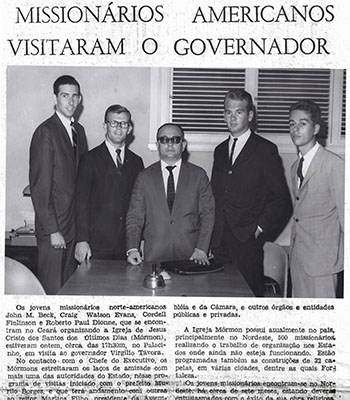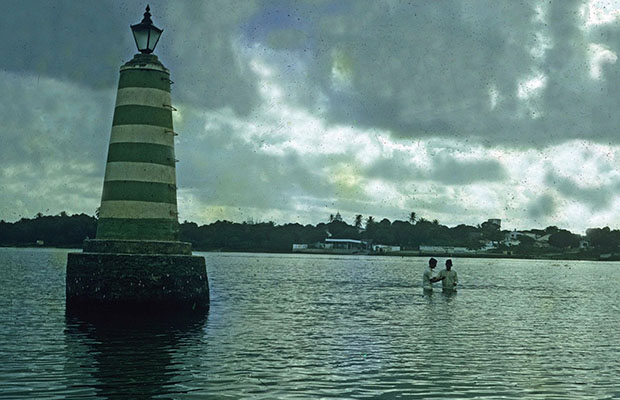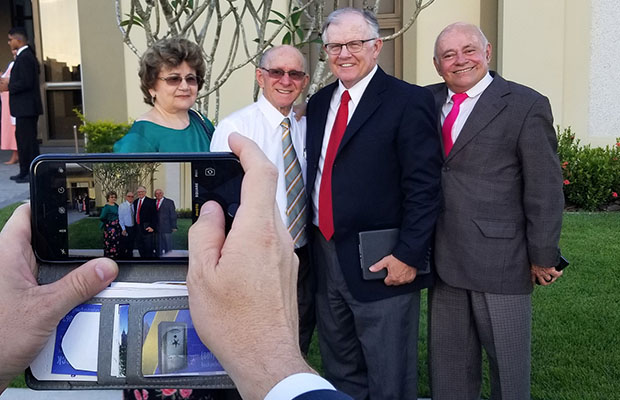Returned Missionaries Reunite with Fortaleza Members to Celebrate Temple Dedication
Contributed By Scott Taylor, Church News managing editor

John M. Beck, second from left, and Antonio Ferreira, center, pause for a photo with Beck’s wife, Lynette, and Ferreria’s wife and family members in Fortaleza, Brazil, on June 1, 2019.
Article Highlights
- Temple dedication is a reminder of the hard work of missionaries and early members to share the gospel in Brazil.
- The Spirit worked miracles in the early days of the Church in Brazil, a time when the missionaries were not allowed to tract.
- Today, Fortaleza is home to 19 stakes and 2 missions.
“This temple will be a source of hope, light, and faith in God for all who come here.” —Elder David A. Bednar of the Quorum of the Twelve Apostles
Related Links
Tears of joy, love, and appreciation flowed freely the day before the dedication of the Fortaleza Brazil Temple as longtime Latter-day Saints reunited with missionaries who had served in Brazil’s northeastern port city in decades past.
Likely, the most heartfelt tears were those waiting more than a half-century to be shared, as members of two of Fortaleza’s first member families—the Ferreiras and the Cintras—reunited with John M. Beck of Provo, Utah, one of the early missionaries who helped teach and convert them in 1966.
“It was very emotional, very emotional,” Lino Cintra said of reconnecting for the first time in more than five decades with Beck, who had baptized him and his wife, Maria, in September 1966.
Beck shared his first return to Brazil with his wife, son, and daughter-in-law. And the Cintras once again welcomed the former missionary back into their home as they spent the days surrounding the June 2 dedication reliving the past and catching up to the present.
“He’s still teaching me,” said Cintra of Beck, who taught seminary and institute in Utah, Idaho, and Arizona for 36 years. “He has such a profound knowledge of the Church and its history.”
While the Cintra-Beck gathering had been planned for some time, what came as a surprise, however, was the appearance of Antonio Ferreira, who with his parents and siblings comprised the first family baptized in Fortaleza earlier in 1966. Baptized at age 16, Ferreira now lives in Natal, Brazil, 435 kilometers (270 miles) south of Fortaleza; many of his family and descendants spread throughout the country are active Church members.
More tears, more embraces, more tender expressions with Ferreira’s unexpected arrival—and more photographs, this time in 2019 with smartphones and instantaneous images.
Besides many such small-group homecomings of former missionaries returning to Fortaleza, the weekend included a number of formal, larger gatherings as well.
Elder Ulisses Soares, the Brazilian member of the Quorum of the Twelve Apostles, led a contingent of visiting Church leaders and their wives in a June 1 afternoon meeting hosting the city’s “pioneer members”—to greet, acknowledge, and thank them for their foundational conversions and decades of Church service.
Standing before the Apostle and the Brazil Area Presidency, the families introduced themselves—the Ferreiras, the Cintras, the Silvas, and many more—with some now four generations strong in spanning Fortaleza’s half-century of Church existence.
The Church’s first Fortaleza roots
President William Grant Bangerter, who presided over the Brazilian Mission from 1959 to 1963 and later became a Church General Authority, sent missionaries to Brazil’s northern cities in the early 1960s. Historical notes from the Brazil Area report missionaries being assigned to Fortaleza in 1962 but withdrawn in 1964 because of a lack of baptisms.

Sharing a tearful reunion are John Beck, left, and Antonio Ferreira, center, on June 1, 2019, in Fortaleza, Brazil. As a missionary in 1966, Beck helped teach and convert the Ferreira family, who were the city’s first Church members. Photo courtesy of Kristy Beck.
On December 23, 1965, Elders John Beck of Nyssa, Oregon, and Robert Dionne of Meriden, Connecticut, arrived in Fortaleza on December 23, 1965, assigned by their mission leader, President Wayne Beck, who had succeeded President Bangerter and who shared a great-great-grandfather with Elder Beck.
Coming from serving in the regions of São Paulo and Rio de Janeiro more than 2,100 kilometers (about 1,400 miles) to the south, the two elders received a simple directive for working in the new city: find families to teach and baptize and men who could receive the priesthood and become local leaders.
“We started from scratch,” recalled Beck, who served the final 13 months of his mission in Fortaleza. “We knew then what the Lord had called us to do.”
With the closest Church branch located some 500 miles away in Recife, the two elders started by residing in a local hotel, then going to the local newspaper offices to announce the arrival of Church representatives in the city. The missionaries made front-page headlines jumping to full-page coverage inside—but they still didn’t have a meeting place to provide an address to those interested in hearing their message. Nor did they have a real residence.

Elder Ulisses Soares of the Quorum of the Twelve Apostles, left, embraces Lino Cintras following a meeting with visiting Church leaders and the pioneer members of Fortaleza, Brazil, on June 1, 2019. Photo by Scott Taylor.
With hotel-room costs starting to cut into their funds, the two went to the local police chief to inquire about possible places to stay. He instead invited them to stay in his family’s home for a period, provided the two American missionaries would help his daughter study English.
Within a month of their arrival, the two received companions. More than a dozen new missionaries flying to mission headquarters in São Paulo had a plane stop in Fortaleza. Elders Beck and Dionne were directed to line up the missionaries outside of the plane, pick their new companions, and pull off their luggage. In such manner, Elder Cordell Finlinson of Oak City, Utah, joined Elder Beck, and Elder Craig Evans joined Elder Donne, with the four missionaries needing to arrange new accommodations.
Not allowed to tract door to door, the elders relied on street contacting and posting banners they had printed up, calling attention to the Church as well as the Mormon Tabernacle Choir. The choir-specific banners, which were popular, often turned up missing. The missionaries also called on the mayor, the governor, and other civic and community leaders.

Elder John Beck, left, and Carlos Cintra, middle, stand at the edge of Lake Messejana in Fortaleza, Brazil, prior to the latter’s baptism on December 31, 1966. Photo courtesy of John M. Beck.
One day walking in the city, the missionaries noticed a man—with a woman and children in tow—waving at them from across the street. “Where have you been? I saw you in the paper,” Elder Beck recalls the man shouting. “When can you teach us?”
The missionaries quickly became acquainted with—and started teaching—Carlos and Gilda Ferreira and their children, five of whom were of baptism age. And baptized they were—first the parents and a son on May 15, 1966, the date specifically selected by Carlos Ferreira, since it was the anniversary of the restoration of the Aaronic Priesthood.

The four missionaries serving in Fortaleza, Brazil, in 1966. Clockwise from top left, Elder Cordell Finlinson, Elder Craig Evans, Elder John Beck, and Elder Robert Dionne. Photo courtesy of John M. Beck.
Beck remembers Raul, the 11-year-old son, as the first of the three to be baptized; other children were baptized in subsequent weeks.
Two other families followed during Elder Beck’s tenure in Fortaleza, including the Cintra family, with baptisms then performed in the city’s Lake Messejana, one of the many bodies of water scattered throughout the city.
As for where the temple stands today in a metropolitan area of some 4 million people, the area 50 years ago was simply undeveloped sand dunes located between the Atlantic beaches and the city of 650,000.
Early on, worship meetings were held in members’ homes, and branch attendance—including visitors participating in Peace Corps efforts in northern Brazil—sometimes surpassed 20 individuals.
However, the Ferreiras moved south to João Pessoa and the second family baptized faded into inactivity, leaving the Cintra family as Fortaleza’s Church members. The missionaries once again were withdrawn for the second time in a half-decade, leaving Lino Cintra to gather his family in their home—alone—to sing hymns, pray, and read the scriptures.
“It was very difficult,” he recalled, pointing to his wife, Maria. “When the missionaries left, she was crying, she was inconsolable.”
The Church in Fortaleza stays put

A full inside part of the January 4, 1966, edition of the Correio do Ceará—one of several newspapers in Fortaleza, Brazil—feature the new missionaries of The Church of Jesus Christ of Latter-day Saints serving in the city. Photo courtesy of John M. Beck.
With the arrival of newly assigned missionaries in Fortaleza, the branch reopened in 1969—never to close again.
In 1971, the Fortaleza Branch received its first non-missionary branch president—Raul Price. A half-dozen years later, the city’s first chapel was constructed, and also in 1977, Fernando José Duarte de Araújo became the first missionary called from the state of Ceará.
Two monumental Church events in 1978 brought immense priesthood and temple blessings along with increased missionary activity—not only in Fortaleza and Brazil but also throughout the world.
The June 9, 1978, announcement of the revelation affording the priesthood to be given to all worthy male members ages 12 and older opened up opportunities among the substantial share of Brazil’s population with black African heritage. Much of Brazil’s black population begins in São Paulo and increases dramatically moving into north and northeastern Brazil, especially along the coastal areas.
With its October 30, 1978 dedication, the São Paulo Brazil Temple became not only the first temple in the country but throughout the continent. And for Church members in Fortaleza and throughout the nation, temple worship and ordinance work went from being all but an impossible dream to a real possibility—albeit one of great sacrifice in time and money.
A typical temple-caravan trip from Fortaleza to São Paulo consisted of three days’ travel to arrive, three days in São Paulo, and then a three-day return.
Conditions then were ripe for Church numbers in Fortaleza to explode, starting in 1979, when the Fortaleza Branch was first divided, with a third branch created from the two later that year.
The Church then flourishes in Fortaleza
The Fortaleza Brazil District—a district and branches being precursors to the formatting of wards and stakes—was organized on July 14, 1980, with Antenor Silva called as district president.
Elder Mark E. Petersen of the Quorum of the Twelve Apostles created the Fortaleza Brazil Stake on July 19, 1981, as some 1,225 members crowded into the Aldeota meetinghouse, with Orville Wayne Day Jr.—a Utah native teaching at a local university—called as the new stake president, and Silva as the first counselor.
(With a job change resulting in the Days moving a year later, Silva was called as the new stake president.)
Consider that in fewer than 400 days, Fortaleza’s district, comprised of 550 members, became a stake of 2,500. That averages to about 170 new members monthly for a year, with most of the six ward bishops having a year or less as members of the Church.

A newspaper clipping shows Virgilio Tavora, center, the governor of the state of Ceará, meeting with the four missionaries serving in Fortaleza, Brazil, in 1966—from left, Elder Craig Evans, Elder John Beck, Elder Cordell Finlinson, and Elder Robert Dionn. Photo courtesy of John M. Beck.
A second stake came in 1983, a third stake the next year, and in 1987, the Brazil Fortaleza Mission was created, with Helvécio Martins—a much-loved leader among the Brazilians and known beyond as the Church’s first black General Authority—as its first president.
In 2000, Fortaleza Latter-day Saints rejoiced with the dedication and opening of the Recife Brazil Temple, considerably closer than the temple in São Paulo but still about 500 miles and an 11-hour drive away. Up until 2019, the city of Fortaleza and the state of Ceará have been part of the massive temple district that includes 80-plus stakes and districts in north and central Brazil.
A temple for Fortaleza
As they viewed the October 2009 general conference, Latter-day Saints in Fortaleza heard President Thomas S. Monson announce a temple for their city, which at the time was home to 13 stakes.
When Elder David A. Bednar of the Quorum of the Twelve Apostles came to preside over the November 15, 2011, groundbreaking at the temple site, the number of stakes had increased to 17. “This temple will be a source of hope, light, and faith in God for all who come here,” Elder Bednar said, adding “the city will always be better and different because of the temple to be built here.”
Today, Fortaleza and Ceará are home to 19 stakes—17 in Fortaleza and its metro area and another two farther inland—as well as two missions and now one operating temple to serve the 90,000 Latter-day Saints living throughout northeastern Brazil.
But the local Latter-day Saints—those who have lived through the early struggles of a branch, a district, and then a stake—a temple isn’t seen as an accomplishment as much as a new beginning.
“I came to know that my relatives who passed away before—my grandpa, my grandma, others whom I loved—could still receive baptism,” said the 81-year-old Lino Cintra, the patriarch of the Fortaleza Brazil Stake since 2006. “The chance they had to know the gospel was through me and my family.”
And gesturing in the direction of Fortaleza’s new temple, he added: “Now, we’re going to see if the results will come.”

Elder John Beck and Carlos Cintra stand in Lake Messejana in Fortaleza, Brazil, preparing for the latter’s baptism on December 31, 1966. Photo courtesy of John M. Beck.

Pausing for a photo by a family member are, from left, Maria Cintra, Lino Cintra, John M. Beck, and Antonio Ferreira on June 1, 2019, outside the stake center on the grounds of the Fortaleza Brazil Temple. The Cintras and Ferreiras were among the first converts baptized in Fortaleza in 1966, with Beck among the four missionaries who taught them. Photo by Scott Taylor.

Elder Robert Dionne, left, and Elder John Beck—presenting a Book of Mormon to the mayor of Fortaleza, Brazil, in 1966—were among the first missionaries to serve in the city. Photo courtesy of John M. Beck.

Elder Ulisses Soares of the Quorum of the Twelve Apostles, right, greets Antonio Ferreria following a meeting with visiting Church leaders and the pioneer members of Fortaleza, Brazil, on June 1, 2019. Photo by Scott Taylor.

The family of Carlos and Gilda Ferreira, joined by Elder John Beck, are photographed on one of the beaches of Fortaleza, Brazil. The Ferreiras were the first converts in Fortaleza, baptized at different times beginning on May 15, 1966; the family moved from Fortaleza later that year. Photo courtesy of John M. Beck.

Maria Cintra pauses for a photo in 1966 in Fortaleza, Brazil. She and her husband, Lino, were baptized that year and were among the first Church members in the city. Photo courtesy of John M. Beck.

One of several banners the missionaries had printed and hung in downtown Fortaleza, Brazil, in 1966. Photo courtesy of John M. Beck.

A view from Fortaleza, Brazil, toward the coastline of the Atlantic Ocean in 1966, when the city of 650,000 had no high-rise hotels and apartments lining the beaches, as the city of nearly 4 million does today. Photo courtesy of John M. Beck.

Fortaleza Mayor Murito Borges, right, greets missionaries serving in the city in 1966—from left, Elder Cordell Finlinson, Elder Robert Dionne, and Elder John Beck. Photo courtesy of John M. Beck.
